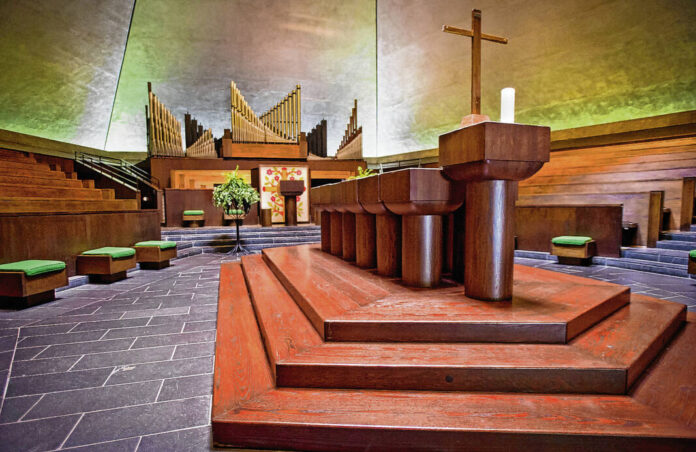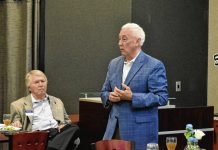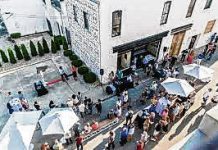
Republic file photo The sanctuary at North Christian Church is pictured on Oct. 2, 2012. The church, which opened in 1964 and is one of seven National Historic Landmarks in Columbus, has been listed as one of Indiana’s 10 Most Endangered historic buildings.
IN a city where a celebrated Modernist bank is now a coffee shop and a heralded Modernist newspaper building is now an architectural classroom, a praised Modernist church possibly could become a library programming space.
That’s what Bartholomew County Public Library leaders are wondering with designer Eero Saarinen’s 1964 jewel known as North Christian Church, according to Jason Hatton, library director. Hatton mentioned that the library is in the midst of hiring a consultant “to develop a strategic plan to help make decisions regarding future space needs and whether North Christian Church might fit” those needs, as he put it.
He emphasized that such is in the very early stages.
Nance Aurand-Humpf, North Christian Church’s board chair, released a statement pertaining to discussions that have unfolded bi-weekly among the library, the church and the nonprofit Landmark Columbus Foundation (as a guide and resource) for several months. With North Christian’s dwindling worship service attendance for nearly the past decade, church leaders recently laid off staff that included Pastor Tonja Gerardy. She confirmed that her last day included the Sunday worship service for March 27.
”Like many mainstream churches, we have seen a steady decline in membership over the last few decades,” Aurand-Humpf said. “Unlike most churches in this category, we have had the added challenge of caring for and protecting a National Historic Landmark and Columbus’ architectural treasure. That is no small feat for an active congregation of fewer than 30 people.”
Gerardy had discussed that challenge openly, especially since the COVID-19 pandemic put even further strain upon some of the struggling houses of worship locally. Even amid the attendance challenge the past decade, and as far back as previous Pastor Lanny Lawler, the church has continued one of its higher-profile, unofficial-but-visible community roles: as a source of spiritual unity and a voice for disenfranchised segments of Bartholomew County, including on issues such as immigration and the LGBTQ community.
It also has hosted such gatherings as a memorial service in 2019 for the Christian victims of Easter church service terrorist bombings in Sri Lanka.
“This year, it became clear that we were on an unsustainable path,” Aurand-Humpf said. “We realized that we would have to lay staff off sooner rather than later if we wanted to help our employees transition to new jobs. I am sad to report that we have done that.
“We are excited about the library’s interest in our building and grounds. We want to leave the building in good hands with an entity that shares our inclusive values. You can’t find a more equitable, inclusive public space than a library.”
Richard McCoy is executive director of the Landmark Columbus Foundation that most recently worked with Lucabe Coffee Company owners converting architect Harry Weese’s Irwin Union Bank-turned-First Financial Bank into a coffee shop at Eastbrook Plaza last year. He acknowledged that he is impressed with the new idea for North Christian.
“From working with that church for years, and from researching and writing a grant for it for The Getty Foundation to create a conservation management plan, I know the background of that church’s aspirations in 1964 when it opened,” said McCoy, who knows local, architecturally significant buildings’ backgrounds about as well as anyone. “I think a library space going in there is the closest thing we can come to to matching the original aspirations of what that church was all about.”
McCoy mentioned that he said that because libraries are seen as diverse, broad-based community organizations that are “among the centerpieces, along with schools, of all our public institutions.”
The church was founded in 1955 and the current structure was completed in 1964 after Saarinen’s death.
Hatton called the library’s current approach with the building a time of “a strategic planning process involving a question of what does the community need and want from us.”
Hatton added that the church’s location, right near a group of schools, makes it ideal for any possible library programming such as speakers and activities for students. Nearby schools include Schmitt Elementary, Northside Middle School, Columbus North High School and St. Bartholomew Elementary School.
“So, we are definitely interested,” Hatton said. ” But we are way, way, far away from making any kind of decision. And we understand that the North Christian congregation is very interested about the legacy of the building.”
As a key leader with the Bartholomew County Historical Society and also a leader last year’s 150th city and county anniversary, Hatton understands the concept of legacy.
“We are a community institution,” Hatton said of the library. “And we know that our community loves history and loves architecture.
“So we have to make sure that the buildings we have here are preserved and used for the best possible purposes.”
North Christian members are wrestling with what becomes of them as a body of believers beyond Easter.
“The future of our faith community is undetermined,” Aurand-Humpf said. “Currently, the congregation has not decided whether to continue in some form or close for good. We plan to continue worship services through Easter and at least once per month in the short term.
“We ask for your prayers as our faith community navigates a most painful and pivotal moment in our history.”




